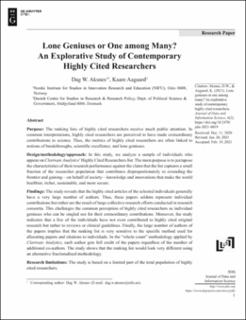| dc.contributor.author | Aksnes, Dag W. | |
| dc.contributor.author | Aagaard, Kaare | |
| dc.date.accessioned | 2021-03-09T14:57:49Z | |
| dc.date.available | 2021-03-09T14:57:49Z | |
| dc.date.created | 2021-03-08T14:15:09Z | |
| dc.date.issued | 2021 | |
| dc.identifier.citation | Aksnes, D. W. & Aagaard, K. (2021). Lone geniuses or one among many? An explorative study of contemporary highly cited researchers. Journal of Data and Information Science, 6(2). | en_US |
| dc.identifier.issn | 2543-683X | |
| dc.identifier.uri | https://hdl.handle.net/11250/2732439 | |
| dc.description.abstract | Purpose: The ranking lists of highly cited researchers receive much public attention. In common interpretations, highly cited researchers are perceived to have made extraordinary contributions to science. Thus, the metrics of highly cited researchers are often linked to notions of breakthroughs, scientific excellence, and lone geniuses.
Design/methodology/approach: In this study, we analyze a sample of individuals who appear on Clarivate Analytics’ Highly Cited Researchers list. The main purpose is to juxtapose the characteristics of their research performance against the claim that the list captures a small fraction of the researcher population that contributes disproportionately to extending the frontier and gaining—on behalf of society—knowledge and innovations that make the world healthier, richer, sustainable, and more secure.
Findings: The study reveals that the highly cited articles of the selected individuals generally have a very large number of authors. Thus, these papers seldom represent individual contributions but rather are the result of large collective research efforts conducted in research consortia. This challenges the common perception of highly cited researchers as individual geniuses who can be singled out for their extraordinary contributions. Moreover, the study indicates that a few of the individuals have not even contributed to highly cited original research but rather to reviews or clinical guidelines. Finally, the large number of authors of the papers implies that the ranking list is very sensitive to the specific method used for allocating papers and citations to individuals. In the “whole count” methodology applied by Clarivate Analytics, each author gets full credit of the papers regardless of the number of additional co-authors. The study shows that the ranking list would look very different using an alternative fractionalised methodology.
Research limitations: The study is based on a limited part of the total population of highly cited researchers.
Practical implications: It is concluded that “excellence” understood as highly cited encompasses very different types of research and researchers of which many do not fit with dominant preconceptions.
Originality/value: The study develops further knowledge on highly cited researchers, addressing questions such as who becomes highly cited and the type of research that benefits by defining excellence in terms of citation scores and specific counting methods. | en_US |
| dc.language.iso | eng | en_US |
| dc.publisher | De Gruyter | en_US |
| dc.rights | Attribution-NonCommercial-NoDerivatives 4.0 Internasjonal | * |
| dc.rights.uri | http://creativecommons.org/licenses/by-nc-nd/4.0/deed.no | * |
| dc.subject | Highly cited researchers | en_US |
| dc.subject | Research excellence | en_US |
| dc.subject | Big science | en_US |
| dc.subject | Citation | en_US |
| dc.subject | Nobel Prize | en_US |
| dc.title | Lone geniuses or one among many? An explorative study of contemporary highly cited researchers | en_US |
| dc.type | Peer reviewed | en_US |
| dc.type | Journal article | en_US |
| dc.description.version | publishedVersion | en_US |
| dc.source.pagenumber | 26 | en_US |
| dc.source.volume | 6 | en_US |
| dc.source.journal | Journal of Data and Information Science | en_US |
| dc.source.issue | 2 | en_US |
| dc.identifier.doi | 10.2478/ jdis-2021-0019 | |
| dc.identifier.cristin | 1896388 | |
| dc.relation.project | Norges forskningsråd: 256223 | en_US |
| cristin.ispublished | true | |
| cristin.fulltext | original | |
| cristin.qualitycode | 1 | |

